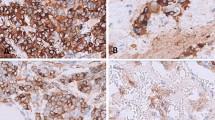Abstract
Thirty-four evaluable patients were treated with vinorelbine, a novel, semisynthetic vinca alkaloid, as first-line chemotherapy for advanced breast cancer. They received vinorelbine 25 mg m-2 i.v. given weekly for a maximum of 16 cycles. Two patients achieved a complete remission and 15 a partial remission, giving a response rate of 17/34 (50%; 95% CI of 34-66%); median response duration was 5.8 months. The median progression-free interval was 4.4 months and median survival 9.9 months. Treatment was generally well tolerated. Fatigue was the most common side-effect. The main reason for dose adjustments was myelosuppression; 68% of patients had WHO grade 3 or 4 neutropenia and there was one death attributed to neutropenic sepsis. Nausea/vomiting and neuropathy were mild and alopecia was uncommon. This study confirms vinorelbine as a highly active, well-tolerated agent in advanced breast cancer worthy of evaluation in combination chemotherapy regimens.
This is a preview of subscription content, access via your institution
Access options
Subscribe to this journal
Receive 24 print issues and online access
$259.00 per year
only $10.79 per issue
Buy this article
- Purchase on Springer Link
- Instant access to full article PDF
Prices may be subject to local taxes which are calculated during checkout
Similar content being viewed by others
Author information
Authors and Affiliations
Rights and permissions
About this article
Cite this article
Twelves, C., Dobbs, N., Curnow, A. et al. A phase II, multicentre, UK study of vinorelbine in advanced breast cancer. Br J Cancer 70, 990–993 (1994). https://doi.org/10.1038/bjc.1994.435
Issue Date:
DOI: https://doi.org/10.1038/bjc.1994.435
This article is cited by
-
Oral vinorelbine versus intravenous vinorelbine, in combination with epirubicin as first-line chemotherapy in Chinese patients with metastatic breast cancer
Cancer Chemotherapy and Pharmacology (2020)
-
A phase II study of docetaxel and vinorelbine plus filgrastim for HER-2 negative, stage IV breast cancer: SWOG S0102
Breast Cancer Research and Treatment (2014)
-
The microtubule as a breast cancer target
Breast Cancer (2011)
-
Phase II study of vinorelbine monotherapy in anthracycline and taxane pre-treated metastatic breast cancer
Investigational New Drugs (2011)
-
Phase II study of an all-oral combination of vinorelbine with capecitabine in patients with metastatic breast cancer
Cancer Chemotherapy and Pharmacology (2009)



